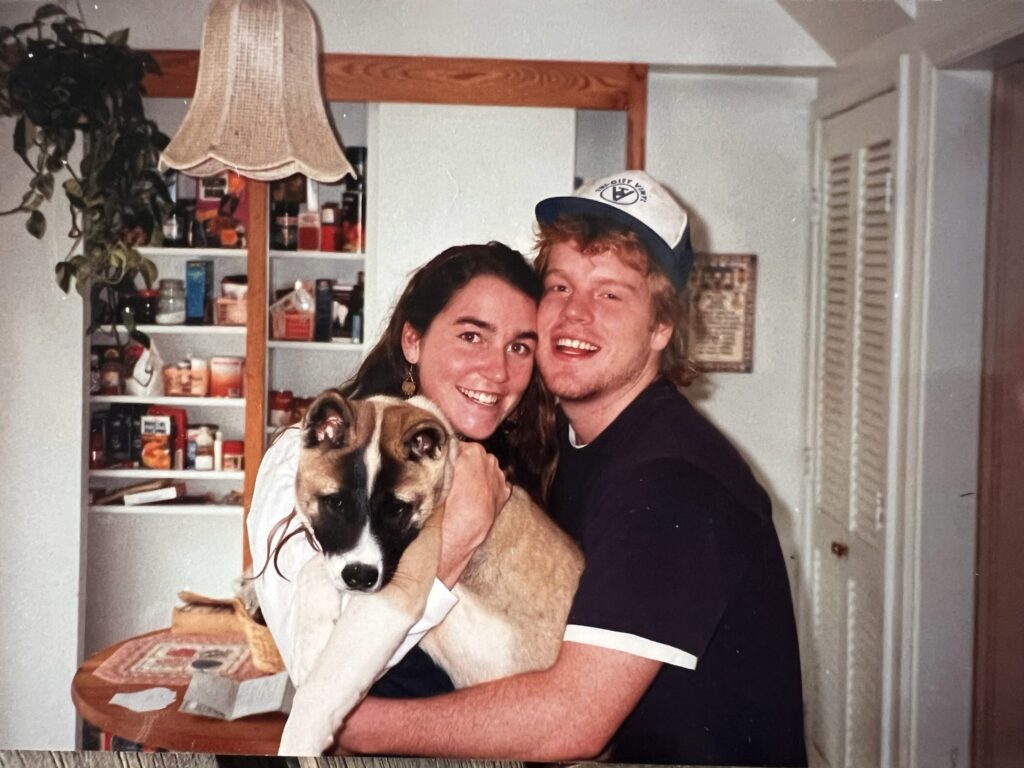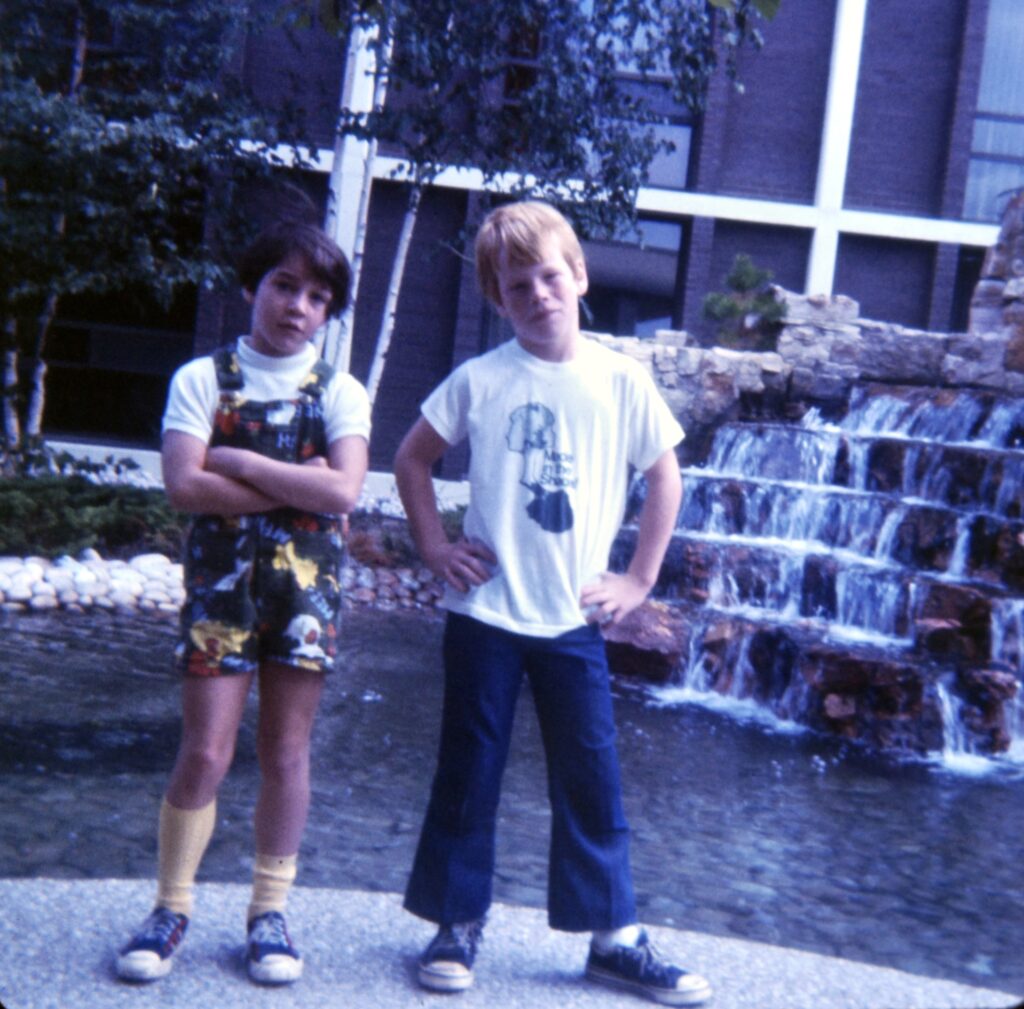Encyclopedia Brown: A Story for My Brother, Philip Seymour Hoffman

Philip, Emily, and their dog, Tess, in the summer of 1990. Photograph by Marilyn O’Connor.
“What do you do with the old magazines when the new issues come out?” I asked the librarian.
“At the end of the year, we donate them to neighborhood schools so kids can cut them up and make collages,” she replied.
Our small public library is relatively new, sparsely filled with only the most popular items: a smattering of pregnancy and parenting books, mostly on sleep training; the latest mystery novels; DVDs on how to build your own she-shed; and a few shelves of history and religion to round it out. We live in a master-planned community filled with parks in a kid-friendly city, so the children’s section is by far the biggest part of the library.
This library is very different from the Rochester Public Library close to where I grew up in New York. I can remember our mom bringing my older brother, Phil, and me to the main branch downtown during school breaks to pass the time. The children’s room was so tucked away you had to crawl through a tiny child-size secret wooden door to get to it. That was my favorite part. The library, which opened in 1936, was massive, dark, and quiet, but inside that small room, there were tall windows where the sun splashed from the Genesee River onto the colorfully illustrated book covers. I wanted to check out dozens of books but knew that my mom would get frustrated trying to find the overdue items missing somewhere in our messy room while late fees piled up.
Phil and I loved reading. We shared a bedroom until our sister went off to college. We had bunk beds; he slept on the bottom. This way, we could each stay up reading with our own flashlight and not disturb the other—though, of course, we found plenty of other reasons to complain about this setup.
Phil loved the Encyclopedia Brown books, and he read a lot of Hardy Boys. He really enjoyed a good mystery, especially if it was funny. He had a lot of favorite movies, but I would say one of his absolute favorites, even as an adult, was The Adventure of Sherlock Holmes’ Smarter Brother (1975), with Gene Wilder, Marty Feldman, and Madeline Khan. In one scene, Gene Wilder, playing Sherlock Holmes’s younger brother, Sigerson, is about to meet the foreign secretary, Lord Redcliff. Sigerson walks into the room alone. Checks his fly to be sure it’s closed. Spies a box of chocolates. Puts one in his mouth. He is startled, and spills the box clumsily to the floor. Just as Lord Redcliff walks in, Sigerson decides the best course of action is to hide all the chocolates in his mouth. With his mouth full and chocolate smeared all over his hands and face, he attempts to hide the empty candy box behind his back. Lord Redcliff spends the rest of the scene shuffling back and forth, peeking around to try and see what Sigerson is hiding.

Emily and Phil at seven and nine years old, 1976. Photograph courtesy of Emily Barr.
I could swear that Phil based much of his acting technique on watching Gene Wilder scenes like this over and over as a kid. The physical comedy is subtle in that the main character is unaware of his buffoonery—only the audience is in on the joke. Phil did this a lot: we would know that something was up, but the character himself was often clueless. This was true both of Phil’s comedic scenes and more dramatic ones: Sandy Lyle sharting at the party in Along Came Polly, Scotty J. trying to kiss Mark Wahlberg’s character in Boogie Nights, and the CIA agent Gust Avrakotos smashing the window in Charlie Wilson’s War. All three characters possess the same loud, obnoxious physicality. And then you see it in more nuanced ways, like when the brother in The Savages sneaks a cookie before the support group meeting is over, or when Freddie Miles plucks the piano keys in The Talented Mr. Ripley, or when Truman Capote takes tiny bites from the baby-food jars in Capote. These gestures brought his characters to life, and made us empathize and identify with their excitement, embarrassment, anger, and heartache.
Even now, when I watch Phil playing these parts in films that now capture a distant past, in roles that have become familiar to us, I can see so much of who he was. He was a cuddly person, much more so than me. He loved to sit close on a couch, walk arm in arm down the street, and hug big. We grew up like two hamsters making nests out of blankets and books. We burrowed together, especially when things felt scary or loud. We made up stories that took us away from the chaos of our house and into building forts in the woods, rowing boats together on Keuka Lake, or walking to The Brick Oven to eat pizza by ourselves like we were grown-ups.
And then there were the loud parts. My brother had a lot of loud parts, like his laughter and big gestures of annoyance. The way he would jump up and dance around when teasing you—even after you’d pleaded for him to stop, he just couldn’t help poking fun one last time. He knew it was wrong, but he was going to do it anyway, and laugh until you were laughing too. And then do it again, until you weren’t laughing, because we Hoffmans are not good at knowing how to stop. We know when to stop, we can tell the mood has shifted, but we always take things one step too far.
Shortly after Phil died, I scoured the library shelves for every periodical that even mentioned him. Early in my twenties, I’d begun saving every magazine or newspaper article Phil was ever featured in—at least the ones I knew about. I even had all his interviews on VHS. And here were the final magazine stories detailing his life cut short. At first, I just wanted to be sure I collected all the glowing obituaries reviewing the life and unexpected death of this talented young actor who mesmerized us with his art. But then I became obsessive. Even the weekly TV Guide put his name in the crossword: 15 down, twenty letters, “Oscar overdose.” I added it to my pile.
“So, these magazines will just get cut up by little kids?” I asked the librarian.
“Yes. Or recycled.”
“What if someone wanted to keep them when the library was done with them?”
“We can’t do that. It’s just too hard to keep track of requests like this.”
I didn’t want to read these articles. But I didn’t want children cutting them up in class next year. More importantly, I didn’t want one of my children to be sitting in art class and get handed one of these magazines and open it up to see their uncle Phil.
So I scooped them all up, handed her my library card, and checked them out. I took them home and went up to my room. I hid in the small space between my bed and the dresser with a pair of scissors I’d stolen from my daughter’s backpack. I sat on the floor and cut all the articles and photos of Phil out of each magazine. I tried to make the missing pages look inconspicuous. But there was no way to really hide it, especially when he was on the cover.
Magazine clippings were everywhere. Our lives had been cut into tiny pieces and gobbled up, and we spent a lot of time trying to hide it all away, including from each other. Eventually, I tucked all the clippings into an old cigar box, which I carefully placed up high on a shelf in my closet. I returned the cut-up magazines to the library, slipping them into the book deposit slot and hoping the cameras wouldn’t catch me. I imagined the librarian deciding to read The New Yorker on her lunch break and realizing that someone had ripped out this key, important article from the magazine. I walked home in the snow, thinking about the mystery I’d created for her with the missing pieces and also how Phil would think I was ridiculous for doing all this. He’d wrap his big arm around me, and we would walk a little quicker as the temperature dropped and the sun set lower in the sky. We would talk, like when we were kids, imagining the story of Encyclopedia Brown trying to solve The Case of the Vanishing Actor, which takes place in a library with a small wooden door.

Em and Phil in New York City, fall of 1987.
Emily Anne Barr is a pediatric nurse practitioner, a midwife, and a nurse scientist caring for families impacted by HIV. Her writing has appeared in the journal AIDS and in The Perch. When her brother died, his last gift to her was a two-year subscription to The Paris Review; she sent a version of this essay to the magazine earlier this year.
